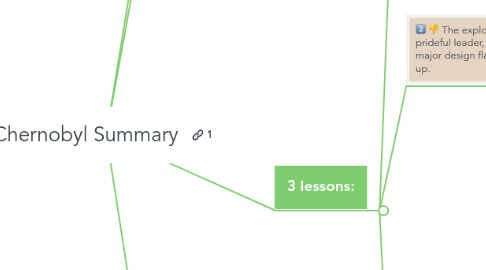
1. 1-Sentence-Summary:
1.1. Chernobyl teaches some fascinating and important history, science, and leadership lessons by diving into the details of the events leading up to the worst nuclear disaster in human history and its aftermath.
2. Favorite quote from the author:
2.1. Altogether, 50 million curies of radiation were released by the Chernobyl explosion, the equivalent of 500 Hiroshima bombs. - Serhii Plokhy
3. 3 lessons:
3.1. A safety test was at the beginning of the events that led to the meltdown.
3.1.1. Nuclear power plants have a lot of potential to generate significant amounts of clean energy.
3.1.1.1. They do this by making nuclear fission happen.
3.1.1.1.1. This is easiest with chemicals like Uranium, which are put into rods.
3.1.1.2. Engineers control the process with water and “control rods” that slow down the reactivity of the elements inside the core.
3.1.1.2.1. When these rods are inside the reactor, the process slows down.
3.1.1.2.2. By removing them, however, nuclear fission is free to carry on and the plant generates more energy.
3.1.2. But these facilities aren’t without their dangers.
3.1.2.1. In some cases, like a bombing, the reactor can lose power and catastrophic failures are not far behind.
3.1.3. This is one reason it was important for personnel at the Chernobyl power plant to conduct a safety test.
3.1.3.1. Their aim was to see how the plant would do if it lost power for a short amount of time.
3.1.3.2. They had backup generators, but the 45 seconds these took to restore power was dangerously long.
3.1.3.3. The aim was to find out if the reactor could safely power itself while the backup power system started up.
3.1.3.3.1. So the plant workers intentionally lowered the electricity input.
3.1.3.3.2. They did this by removing the control rods from the reactor while simultaneously reducing input power to the plant.
3.1.4. But the test which began in the early hours of April 26, 1986, went horribly wrong.
3.2. The explosion happened because of a prideful leader, incompetent staff, and a major design flaw that the USSR covered up.
3.2.1. It’s Friday afternoon and the night crew is beginning their shift at Chernobyl.
3.2.2. However, the leader, Yuri Tregub, didn’t feel well-acquainted with the procedure for the test they had to conduct that night.
3.2.2.1. Luckily, or rather unluckily, Anatoly Dyatlov, deputy chief-engineer was there to oversee the operation.
3.2.3. By 10 pm the team had the go-ahead to begin, and by 11 Dyatlov had arrived.
3.2.3.1. Although Tregub asked for help, Dyatlov dismissed his questions.
3.2.3.2. This arrogant leader pushed the team to keep working regardless of their uncertainties because he didn’t know about the fatal design flaw in the reactor.
3.2.4. They began the test anyway, reducing power in the reactor.
3.2.5. Dyatlov continued to scold the crew for not working fast enough despite their questions.
3.2.5.1. When the machine struggled to maintain power on its own, Dyatlov only pushed them to keep going.
3.2.6. Eventually, only nine control rods remained in the core.
3.2.7. Even though power was low, the enormous amount of nuclear reactions boiled all water in the reactor into steam.
3.2.7.1. The rapid increase in temperature spiked the power and Leonid Totunov pressed the emergency shutdown button, sending all control rods back in.
3.2.7.1.1. But the RBMK reactor, which wasn’t legal anywhere else in the world because of its risky setup, had a critical flaw.
3.2.7.2. When the control rods went into the already dangerous core, it sent the power even higher.
3.2.7.2.1. Two explosions tore through the reactor core and sent radioactive material everywhere.
3.3. The official response to the disaster was slow, which led to many people dying early from the eventual effects of radiation.
3.3.1. The Fire Department was the first to arrive on the scene.
3.3.2. Little fires were everywhere, but they had to focus on the roof of the building first.
3.3.3. Their standard protective gear wasn’t enough to protect them from the intense radiation, however.
3.3.3.1. The radioactive heat began melting their boots.
3.3.3.2. Pieces of graphite lay across the roof spontaneously combusting, and the firefighters just kicked these to the ground not knowing what they were.
3.3.3.3. One of them found metal in the tires of a truck and lost the skin from his hands after removing it.
3.3.4. It wasn’t long before they all began to get intensely sick from the radiation.
3.3.4.1. Many of them would later die because of it.
3.3.5. The horror these men experienced was sadly the result of corrupt leadership that were in denial about the situation.
3.3.5.1. Workers at the plant didn’t believe an explosion in the core had or even could have happened, so they didn’t tell the authorities the reactor was damaged.
3.3.5.2. Those in the control room thought the only damage was in the turbine hall.
3.3.6. Even higher authorities were in denial.
3.3.6.1. The director of the plant itself for example, only sent a memo to leaders in Kyiv only saying that the reactor hall was damaged.
3.3.6.2. He told them that the radiation levels were 1,000 micro roentgen even though he knew this was the maximum their instruments could measure.
3.3.6.3. He completely ignored one worker that had better equipment that told him of the 55,000 micro roentgen on his device.
3.3.7. This meant that the response was slow.
3.3.8. Not only did many of the initial responders lose their lives, but countless others did too.
3.3.8.1. The fires spewed tons of radioactive material into the atmosphere and we can only guess at how many people would later get cancer because of this disaster.
